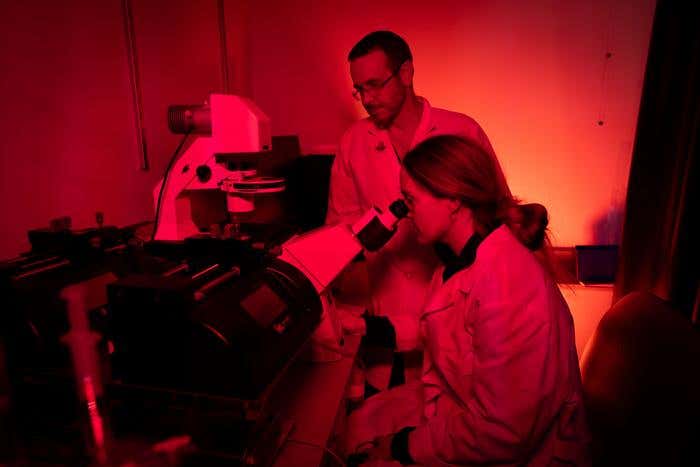Red light therapy significantly reduces blood clot formation
Discover how red light therapy reduces blood clots and stroke risk, offering a groundbreaking, non-invasive prevention method.

Researchers reveal that red light therapy could revolutionize blood clot prevention, cutting risks for heart attacks, strokes, and venous thromboembolism. (CREDIT: Tim Betler, UPMC)
Light has long been recognized as a critical regulator of human health, influencing everything from hormone secretion to cardiovascular rhythms.
Published in the journal, Journal of Thrombosis and Haemostasis, recent research from the University of Pittsburgh School of Medicine and UPMC suggests that long-wavelength red light could play a transformative role in preventing blood clots, a leading cause of preventable death worldwide.
By examining its effects on mice and humans, researchers uncovered compelling evidence of the potential therapeutic benefits of red light exposure.
Using a murine model of venous thrombosis, scientists demonstrated that exposure to red light significantly reduces clot formation. Mice exposed to red light prior to inferior vena cava (IVC) ligation developed clots that were notably smaller compared to those exposed to white or blue light.
The average clot weight for red light-exposed mice was 7.20 mg, compared to 18.00 mg for white light and 23.60 mg for blue light. However, this effect disappeared when the light exposure occurred after the ligation, underscoring the importance of timing in red light therapy.
Further experiments revealed that the optic pathway plays a crucial role in mediating this response. Blind mice, genetically unable to sense light, showed no significant differences in clot size regardless of the wavelength of light exposure.
Additionally, platelets exposed directly to red light outside the body exhibited no change in thrombosis, confirming that the effect is optically mediated. These findings suggest that the beneficial effects of red light exposure depend on the body's ability to process light signals through the visual system.
To ensure the observed benefits were not influenced by other physiological changes, researchers evaluated the circadian activity, sleep patterns, metabolism, and coagulation markers of the mice. No significant differences were found across groups in these parameters, suggesting that red light’s effects on thrombosis are independent of broader metabolic or hormonal shifts.
Interestingly, red light exposure correlated with reduced neutrophil extracellular traps (NETs), web-like structures produced by immune cells that can contribute to clot formation. These structures, while essential for trapping pathogens, can exacerbate clotting by ensnaring platelets.
Reducing NET formation may therefore help decrease thrombotic risk. Additionally, red light exposure increased fatty acid production, a process known to inhibit platelet activation and further reduce clot formation.
Related Stories
The researchers also ruled out changes in activity levels, sleep-wake cycles, caloric intake, and body temperature as potential confounding factors. Their meticulous approach underscores the robustness of their findings and highlights the specific impact of red light on thrombosis.
The study also explored the impact of red light on arterial thrombosis using a murine model of ischemic stroke. Following middle cerebral artery occlusion, mice exposed to red light exhibited a 47% reduction in brain infarct size compared to those exposed to white or blue light.
These mice also demonstrated improved neurological and motor function, as measured by standardized tests such as the Bederson test and the rotarod performance test. These improvements provide further evidence of red light’s protective effects in thrombotic conditions.
Given the shared mechanisms of arterial and venous thrombosis, the findings suggest that red light could be a universal preventative strategy against clot-related conditions. By modulating immune-coagulation interactions and reducing inflammation, red light appears to provide a non-invasive approach to lowering thrombotic risk.
In parallel with animal studies, researchers analyzed data from over 10,000 patients who underwent cataract surgery. Patients who received blue light-filtering lenses—which transmit less blue light—had a lower incidence of venous thromboembolism, particularly among cancer patients, who are at higher risk for clots. This reinforces the potential for light modulation as a preventive tool in humans.
“The light we’re exposed to can change our biological processes and change our health,” said Dr. Elizabeth Andraska, lead author and assistant professor of surgery at Pitt. She noted that the findings could pave the way for inexpensive therapies benefiting millions of people worldwide.
The team is now developing red light goggles to control light exposure for clinical trials. These devices aim to refine the therapy’s dosage and identify individuals who might benefit the most.
Additionally, the researchers are investigating the biological pathways by which red light influences clotting, potentially leading to new medications or therapies that could offer more convenience than continuous light exposure.
The human data also highlighted an intriguing relationship between light exposure and cancer patients, who are nine times more likely to develop blood clots compared to non-cancer patients. The observation that blue light-filtering lenses lowered clotting risk in this population suggests a unique avenue for improving outcomes in vulnerable groups.
The study’s findings could have profound implications for global health. Venous thromboembolism affects up to 10 million people annually, while arterial thrombosis contributes to over 12 million strokes each year.
Current treatments often rely on anticoagulants, which carry significant bleeding risks. Red light therapy offers a promising alternative, reducing thrombotic risk without compromising safety.
The recently published study also found that red light exposure is associated with less inflammation and activation of the immune system. For example, red light-exposed mice had fewer NETs, which not only trap microorganisms but also entangle platelets, contributing to clot formation. By reducing these inflammatory responses, red light helps lower the risk of clot-related complications.
“These results are unraveling a fascinating mystery about how the light we’re exposed to on a daily basis influences our body’s response to injury,” said Dr. Matthew Neal, senior author and trauma surgeon at UPMC. “Our next steps are to figure out why, biologically, this is happening, and to test if exposing people at high risk for blood clots to more red light lowers that risk.”
The researchers’ meticulous approach included examining whether direct light exposure to blood could replicate the effects. However, they found that red light’s benefits were entirely dependent on the optic pathway, as blind mice showed no change in clotting behavior regardless of light exposure. This underscores the importance of visual processing in mediating the therapy’s effects.
By illuminating the complex interplay between light and human biology, this research highlights a groundbreaking approach to reducing deaths and disabilities caused by blood clots. As clinical trials progress, the potential to save lives with a simple, non-invasive intervention becomes increasingly clear.
In preparation for future applications, the team is exploring wearable red light devices, such as goggles, to ensure targeted and controlled exposure. These innovations could make red light therapy an accessible and affordable option for at-risk populations worldwide.
Understanding how red light alters immune and coagulation pathways may also lead to the development of novel drugs that mimic its effects without requiring light exposure.
Ultimately, the study offers hope for addressing a significant global health challenge. By integrating red light therapy into preventive care, healthcare providers could reduce the burden of thrombotic diseases, improve patient outcomes, and save countless lives.
Note: Materials provided above by The Brighter Side of News. Content may be edited for style and length.
Like these kind of feel good stories? Get The Brighter Side of News' newsletter.
Joshua Shavit
Science & Technology Writer | AI and Robotics Reporter
Joshua Shavit is a Los Angeles-based science and technology writer with a passion for exploring the breakthroughs shaping the future. As a contributor to The Brighter Side of News, he focuses on positive and transformative advancements in AI, technology, physics, engineering, robotics and space science. Joshua is currently working towards a Bachelor of Science in Business Administration at the University of California, Berkeley. He combines his academic background with a talent for storytelling, making complex scientific discoveries engaging and accessible. His work highlights the innovators behind the ideas, bringing readers closer to the people driving progress.



